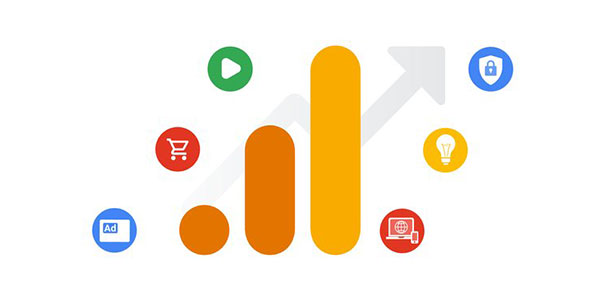GA4 is the latest version of Google Analytics (GA) that combines data or ‘data streams‘ from both apps (for example iOS and Android) and websites. Universal Analytics or GA3 is currently the most used version of the Analytics platform.
GA4 has actually already been around for sometime, it was previously named ‘App + Web’ and evolved from Firebase Analytics.
On 16th March 2022 Google announced their plan to sunset Universal Analytics (https://blog.google/products/marketingplatform/analytics/prepare-for-future-with-google-analytics-4/) and encourage users to migrate to GA4.
All standard Universal Analytics properties will stop processing new hits on July 1, 2023. Universal Analytics 360 properties will receive an additional three months of new hit processing, ending on October 1, 2023.
An important point to note is that data is not migrated from UA to GA4. A new GA4 Property will only collect data from the time of implementation.
If data is valuable to your company for reporting and monitoring KPI’s or optimising campaigns then having a back log of data already at disposal ready for when you fully switch to GA4 is vital.
Eventually, GA4 will be the standard for analytics (just as Universal Analytics has been). The evolving nature of internet technology has demanded a shift in tracking technologies to be able to navigate issues surrounding GDPR / Cookies and sophistication of web development.
Major Differences between UA/GA3 and GA4
- The interface. GA4 may look intimidating because many of the reports, dimensions and metrics your were used to with UA have either been removed or replace.
- The underlying tracking methodology. The platforms are very different and this is underpinned by a migration from Session based tracking in UA to Event based in GA4. This means that tracking is recorded and presented in a hit by hit basis in GA4, whereas in Universal Analytics all hits were tied to a particular Session or User. This essentially means GA4 is poised to handle cookieless tracking.
- The standard reports in GA4 are all new and very top level. Deeper analysis requires the user to create custom reports. If you rely on UA’s standard reports you will have to build custom solutions to match these in GA4 using either the Analysis Hub or an external data manipulation tool such as BigQuery or DataStudio.
- The tracking ID format. A UA tracking ID looks similar to UA-12345-1, whereas GA4 is similar to G-123451.
- Extra default data points. Scroll depth, form submits, on-site searches, file downloads and outbound link clicks are now all tracked by default. This was only possible in UA by adding custom tracking enhancements.
- View / Property setup. UA allowed the creation of multiple Views to be nested within a Property to segment data by territory, sub-domain, etc. GA4 does not (yet) acomodate Views within a Property. Any data segmentation must be done by set data streams for different sources of data, or creating Segments and applying them to the data set you are analysing or by creating multiple Properties for each data source.
- Ecommerce. The ecommerce tracking in GA4 is still in its infancy.
New Features are Still Being Released
Bounce Rate was previously deprecated in GA4, but was recently announced to be re-introduced as the inverse of the new metric Engagement Rate.
GA4 is still missing in built filters (the work around is to filter data at the implementation phase in GTM) and the ability to segment Properties into filtered Views. Note. it is not recommended to treat Data Streams as Views.
Charles Farina maintains a Google Sheet tracking GA4 feature releases and work arounds for missing items.
Features and Highlights
- Integration with Google Tools. BigQuery (a data warehouse and querying tool) was previously only available to GA360 customers. For anyone with SQL knowledge this is a powerful way to run custom queries fast without any issues of data sampling.
- Machine learning. A combinination of artificial intelligence and data science, is integrated into the new GA4 platform. Using machine learning, GA4 fills in data gaps and provides sophisticated insights about user behavior, trends, and anomalies.
- Cross-platform Analytics. Tracking users across apps and web was previously not possible. GA4 offers a solution to collect standardized data across multiple platforms.
Prepare for a GA4 Migration
It is recommended to run a dual tagged implementation of UA and GA4 side by side until widespread adoption has been achieved and your teams are comfortable with the new interface and challenges a new platform brings.
Getting a GA4 implementation in place before July 1st 2022 is very desirable so that you have 1 year+ of data in GA4 at the time that UA stops processing new hits.
More info: https://support.google.com/analytics/answer/9964640
With regards to timescales it really depends on the website and the state of the current tracking implementation.
The preferred method of implementation is by far using Google Tag Manager. All of the Ecommerce and lead gen tracking implementations that I have built in the last year are forward compatible for GA4 in preparation for the inevitable switch, meaning that we can build on the foundation that is already put in place.
For new sites and especially Ecommerce sites the consideration requires planning. Setting up Ecommerce tracking is complicated in GA4, just as it was in Universal Analytics.
The road map is the same for any analytics project:
- Audit / scoping
- Design a measurement framework
- Implementation work and platform optimisation
Things to Avoid
Switching off or abandoning Universal Analytics and replacing it with a standalone GA4 implementation. Theres a learning curve to GA4, it’s more of a professional tool than UA.

